Fluke PM3370B User Manual
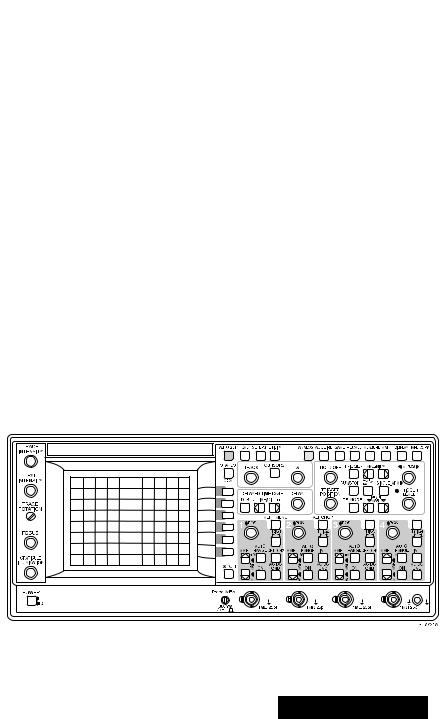
I
$XWRUDQJLQJ &RPEL6FRSH™ ,QVWUXPHQW
30 % 30 % 30 %
30 % 30 %
Users Manual |
|
|
|
|
|
|
|
|
|
|
|
|
2/1- Nov-1998 |
||||||||||||||||||
|
|
|
|
|
|
|
|
|
|
|
|
|
|
|
|
|
|
|
|
|
|
|
|
|
|
|
|
|
|
|
|
|
|
|
|
|
|
|
|
|
|
|
|
|
|
|
|
|
|
|
|
|
|
|
|
|
|
|
|
|
|
|
|
|
|
|
|
|
|
|
|
|
|
|
|
|
|
|
|
|
|
|
|
|
|
|
|
|
|
|
|
|
|
|
|
|
|
|
|
|
|
|
|
|
|
|
|
|
|
|
|
|
|
|
|
|
|
|
|
|
|
|
|
|
|
|
|
|
|
|
|
|
|
|
|
|
|
|
|
|
|
|
|
|
|
|
|
|
|
|
|
|
|
|
|
|
|
|
|
|
|
|
|
|
|
|
|
|
|
|
|
|
|
|
|
|
|
|
|
|
|
|
|
|
|
|
|
|
|
|
|
|
|
|
|
|
|
|
|
|
|
|
|
|
|
|
|
|
|
|
|
|
|
|
|
|
|
|
|
|
|
|
|
®

II
IMPORTANT
In correspondence concerning this instrument please give the model number and serial number as located on the type plate on the rear of the instrument.
NOTE: The design of this instrument is subject to continuous development and improvement. Consequently, this instrument may incorporate minor changes in detail from the information provided in this manual.
Fluke Corporation |
Fluke Industrial B.V. |
P.O. Box 9090 |
P.O. Box 680 |
Everett WA |
7600 AR Almelo |
98206-9090, USA |
The Netherlands |
Copyright ã 1997, 1998 Fluke Corporation
All rights reserved. No part of this manual may be reproduced by any means or in any form without written permission of the copyright owner.
Printed in the Netherlands
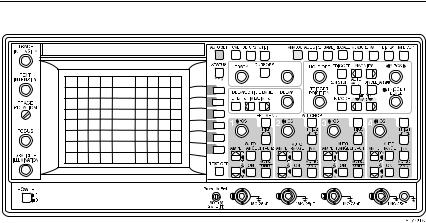
III
Thank you for purchasing this FLUKE oscilloscope. It has been designed and manufactured to the highest quality standards to give you many years of trouble free and accurate measurements.
The powerful measuring functions listed below have been combined with an easy and logical operation to let you use the full power of this instrument each and every day.
If you have any comments on how this product could be improved, please contact your local FLUKE organization. FLUKE addresses are listed in the back of the REFERENCE MANUAL.
The REFERENCE MANUAL also contains:
-CHARACTERISTICS AND SPECIFICATIONS
-PRINCIPLES OF OPERATION
-BRIEF CHECKING PROCEDURE
-PERFORMANCE TEST PROCEDURES
-PREVENTIVE MAINTENANCE PROCEDURES

IV
MAIN FEATURES
There are five models in this family of FLUKE oscilloscopes. Each of these models is a combination of an analog real-time oscilloscope and a fully featured digital storage oscilloscope. By pressing a single key, you can switch the instrument from the analog mode to the digital mode and back. This allows each of the units to be used in an optimum operating mode for all kinds of signal conditions. Complex data streams, modulated waveforms, and video signals can often best be seen in the analog mode of operation. The digital mode of operation is more suited for single events, signals with low repetition frequencies, and when automatic measurements need to be performed.
In this family there is a choice of five models. Two models have a bandwidth of 200 MHz, two have a bandwidth of 100 MHz and one has a bandwidth of 60 MHz. Beside the 2 channel models with EXT TRIG input, there is a choice of two models with four fully featured channels, all shown in the following table:
Type Number |
Bandwidth |
Sample rate |
Number of |
Input |
|
|
|
Channels |
Impedance |
|
|
|
|
|
PM3370B |
60 MHz |
200 MS/s |
2 |
1 MΩ |
PM3380B |
100 MHz |
200 MS/s |
2 |
1 MΩ |
PM3384B |
100 MHz |
200 MS/s |
4 |
1 MΩ |
PM3390B |
200 MHz |
200 MS/s |
2 |
1 MΩ/50Ω |
PM3394B |
200 MHz |
200 MS/s |
4 |
1 MΩ/50Ω |
|
|
|
|
|
In the same instrument family, there are two 200-MHz and two 100-MHz analog oscilloscopes that have specifications similar to the above-mentioned analog/ digital combination oscilloscopes operating in analog mode.
All analog/digital combination oscilloscopes listed above have the following features:
-Autoranging attenuators.
-Realtime clock.
-32K sample acquisition memory in 4 channel versions.
-8K sample acquisition memory, expandable to 32K in 2 channel versions.
-Up to 40 waveforms stored in memory or 204 waveforms with optional memory extension.
-Autoset function for an instant optimized signal display at the touch of a button.
-Autoranging timebase.
-Cursor measurements with 1% accuracies.
-Extensive set of fully automated voltmeter and time measurement functions.
-Probe operated ’Touch Hold and Measure’ function freezes the display and instantly displays the signal frequency, amplitude and dc voltage level.

V
-Peak detection for the capture of glitches as narrow as 5 ns.
-Pattern, State and Glitch triggering (2 ns) (2 channel models; 4ns Glitch triggering only)
-Event delay and pretriggering and posttriggering.
-TV triggering including HDTV and TV line selection.
-Serial interface for printing and plotting.
-Averaging to reduce signal noise and to increase the vertical resolution from 8 to 16 bits.
-Advanced mathematics, including digital low-pass filtering. A Math+ option adds integration, differentiation, histogramming, and FFT.
-Sine interpolation and magnification which enables true to life four channel single shot acquisitions with a timebase up to 625 ns/div (32x magnified)
-A delayed timebase with full trigger features.
-An RS-232 (EIA-232-D) interface (standard) and an GPIB/IEEE-488 interface (optional).
-Autocal for automatic fine tuning of all circuitry to achieve maximum accuracy under all user conditions.
-Closed case calibration for efficient maintenance of traceable calibration at minimum cost.
The following options are available:
-A MATH+ option with more automated measurement functions including envelope and measurement pass/fail testing. Also included in this option are Integration, Differentiation, Histogramming, and FFT.
-Memory extension offering 32K acquisition length and the ability to store 156 traces (of 512 samples each) in memory for 2 channel versions.
-IEEE-488.2 interface using the new SCPI (Standard Commands for Programmable Instruments) industry standard for remote control of test and measurement equipment.

VI
INITIAL INSPECTION
Check the contents of the shipment for completeness and note whether any damage has occurred during transport. When the contents are incomplete or there is damage, file a claim with the carrier immediately. Then notify the FLUKE Sales or Service organization to arrange for the repair or replacement of the instrument or other parts. FLUKE addresses are listed in the back of the REFERENCE MANUAL.
The following parts should be included in the shipment:
|
|
Service ordering number |
|
|
or model number |
1 |
Oscilloscope |
PM3370B, PM3380B or |
|
|
PM3390B, PM3384B or |
|
|
PM3394B |
1 |
Front cover |
5322 447 70121 |
1 |
Users Manual |
|
1 |
Reference Manual |
|
1 |
Line cord (European type) or |
5322 321 21616 |
1 |
Line cord (North American type) or |
5322 321 10446 |
1 |
Line cord (British type) or |
5322 321 21617 |
1 |
Line cord (Swiss type) or |
5322 321 21618 |
1 |
Line cord (Australian type) |
5322 321 21781 |
2 |
Probes 10:1 |
|
2 |
Batteries |
AA (LR6) |
1 |
Spare fuse 3.15 AT |
4822 070 33152 |
|
(located inside fuse holder) |
|
The performance of the instrument can be tested by using the PERFORMANCE TESTS in the REFERENCE MANUAL.

VII
INSIDE THIS MANUAL
This operating guide contains information on all of the oscilloscope’s features. It starts with a general introduction, a summary of main capabilities, initial inspection note and a front and rear view.
Operators safety |
Chapter 1 should be read before unpacking, |
|
installing, and operating the instrument. |
Installation instructions |
Chapter 2 describes grounding, line cord, fuses, |
|
and backup batteries. |
Getting started |
Chapter 3 provides a 10-minute tutorial intended |
|
for those who are not familiar with Fluke |
|
oscilloscopes. |
How to use more advanced |
Chapter 4 provides the more experienced user |
functions of the instrument |
with a detailed explanation of the major functions |
|
of the oscilloscope. |
Function reference |
Chapter 5 contains an alphabetized description of |
|
each function. Each description includes an |
|
explanation of local and remote control functions. |
CPL protocol |
Chapter 6 provides the CPL commands with an |
|
example of each. |
Function index |
The Function Index lists all implemented |
|
functions in alphabetical order. |
Index |
The overall index contains all function names |
|
and reference words in alphabetical order. It |
|
includes the relevant chapter and page number |
|
where more detailed information can be found. |
IN THE APPENDICES |
|
Menu structures |
|
RS-232 |
Cable configurations |
VIII |
CONTENTS |
CONTENTS |
Page |
1 OPERATORS SAFETY . . . . . . . . . . . . . . . . . . . . . . . . . . . . . . . . 1-1
1.1 INTRODUCTION . . . . . . . . . . . . . . . . . . . . . . . . . . . . . . . . . . . . . . . 1-1
1.2 |
SAFETY PRECAUTIONS . . . . . . . . . . . . . . . . . . . . . . . . . . . . . . . . |
1-1 |
1.3 |
CAUTION AND WARNING STATEMENTS . . . . . . . . . . . . . . . . . . |
1-1 |
1.4 |
SYMBOLS . . . . . . . . . . . . . . . . . . . . . . . . . . . . . . . . . . . . . . . . . . . . |
1-2 |
1.5 |
IMPAIRED SAFETY PROTECTION . . . . . . . . . . . . . . . . . . . . . . . . |
1-2 |
1.6 |
MEASURING EARTH . . . . . . . . . . . . . . . . . . . . . . . . . . . . . . . . . . . |
1-2 |
2 INSTALLATION INSTRUCTIONS . . . . . . . . . . . . . . . . |
. . . . . 2-1 |
||
2.1 |
SAFETY INSTRUCTIONS . . . . . . . . . . . . . . . . . . . . . . . . . . . |
. . . . . 2-1 |
|
|
2.1.1 |
Protective earthing . . . . . . . . . . . . . . . . . . . . . . . . . . |
. . . . . 2-1 |
|
2.1.2 Mains voltage cord, mains voltage range and fuses |
. . . . . 2-1 |
|
2.2 |
MEMORY BACK-UP BATTERIES . . . . . . . . . . . . . . . . . . . . |
. . . . . 2-3 |
|
|
2.2.1 |
General information . . . . . . . . . . . . . . . . . . . . . . . . . . |
. . . . 2-3 |
|
2.2.2 |
Installation of batteries . . . . . . . . . . . . . . . . . . . . . . . . |
. . . . 2-3 |
2.3 THE FRONT COVER . . . . . . . . . . . . . . . . . . . . . . . . . . . . . . . . . . . . 2-3
2.4 HANDLE ADJUSTMENT AND OPERATING
POSITIONS OF THE INSTRUMENT . . . . . . . . . . . . . . . . . . . . . . . . 2-4
2.5 IEEE 488.2/IEC 625 BUS INTERFACE OPTION . . . . . . . . . . . . . . |
2-4 |
2.6 RS-232-C SERIAL INTERFACE . . . . . . . . . . . . . . . . . . . . . . . . . . . 2-5
2.7 RACK MOUNTING . . . . . . . . . . . . . . . . . . . . . . . . . . . . . . . . . . . . . 2-5
2.8 VERSIONS . . . . . . . . . . . . . . . . . . . . . . . . . . . . . . . . . . . . . . . . . . . . 2-5
CONTENTS |
IX |
3 GETTING STARTED . . . . . . . . . . . . . . . . . . . . . . . . . . . . . . . . . . . 3-1
3.1 FRONT-PANEL LAYOUT . . . . . . . . . . . . . . . . . . . . . . . . . . . . . . . . 3-1
3.2 SWITCHING ON THE INSTRUMENT . . . . . . . . . . . . . . . . . . . . . . . |
3-2 |
3.3 SCREEN CONTROLS . . . . . . . . . . . . . . . . . . . . . . . . . . . . . . . . . . . 3-3
3.4 AUTO SETUP . . . . . . . . . . . . . . . . . . . . . . . . . . . . . . . . . . . . . . . . . 3-4
3.5 MODE SWITCHING BETWEEN ANALOG AND
DIGITAL OPERATING MODES . . . . . . . . . . . . . . . . . . . . . . . . . . . . 3-6
3.6 VERTICAL SETUP . . . . . . . . . . . . . . . . . . . . . . . . . . . . . . . . . . . . . . 3-8
3.7 TIMEBASE SETUP . . . . . . . . . . . . . . . . . . . . . . . . . . . . . . . . . . . . 3-11
3.8 MAGNIFY (EXPAND) . . . . . . . . . . . . . . . . . . . . . . . . . . . . . . . . . . . 3-12
3.9 DIRECT TRIGGER SETUP . . . . . . . . . . . . . . . . . . . . . . . . . . . . . . 3-13
3.10 PRE-TRIGGER VIEW . . . . . . . . . . . . . . . . . . . . . . . . . . . . . . . . . . 3-15
3.11 MORE ADVANCED FEATURES . . . . . . . . . . . . . . . . . . . . . . . . . . 3-16
3.12 CURSOR OPERATION . . . . . . . . . . . . . . . . . . . . . . . . . . . . . . . . . 3-17
3.13 MORE ADVANCED TRIGGER FUNCTIONS . . . . . . . . . . . . . . . . 3-19
3.14 MORE SIGNAL DETAIL WITH THE DELAYED TIMEBASE . . . . 3-20
3.15 TRACE STORAGE . . . . . . . . . . . . . . . . . . . . . . . . . . . . . . . . . . . . 3-22
4 HOW TO USE MORE ADVANCED FUNCTIONS |
|
|
OF THE INSTRUMENT . . . . . . . . . . . . . . . . . . . . . . . . . . . . . . . |
. 4-1 |
|
4.1 |
INTRODUCTION . . . . . . . . . . . . . . . . . . . . . . . . . . . . . . . . . . . . . . . |
4-1 |
4.2 |
DISPLAY AND PROBE ADJUSTMENTS . . . . . . . . . . . . . . . . . . . . |
4-5 |
4.3 |
ANALOG AND DIGITAL MODES . . . . . . . . . . . . . . . . . . . . . . . . . . |
4-9 |
4.4 |
VERTICAL DEFLECTION . . . . . . . . . . . . . . . . . . . . . . . . . . . . . . . |
4-13 |
4.5 |
HORIZONTAL DEFLECTION AND TRIGGERING . . . . . . . . . . . . |
4-22 |
X |
CONTENTS |
4.6 DIGITAL ACQUISITION AND STORAGE . . . . . . . . . . . . . . . . . . . 4-30
4.7 ADVANCED VERTICAL FUNCTIONS . . . . . . . . . . . . . . . . . . . . . 4-31
4.8 ADVANCED HORIZONTAL AND TRIGGER FUNCTIONS . . . . . 4-34
4.9 MEMORY FUNCTIONS . . . . . . . . . . . . . . . . . . . . . . . . . . . . . . . . . 4-39
4.10 CURSORS FUNCTIONS . . . . . . . . . . . . . . . . . . . . . . . . . . . . . . . . 4-44
4.11 MEASUREMENT FUNCTIONS . . . . . . . . . . . . . . . . . . . . . . . . . . . 4-49
4.12 PROCESSING FUNCTIONS . . . . . . . . . . . . . . . . . . . . . . . . . . . . . 4-54
4.13 DISPLAY FUNCTIONS . . . . . . . . . . . . . . . . . . . . . . . . . . . . . . . . . 4-57
4.14 DELAYED TIMEBASE . . . . . . . . . . . . . . . . . . . . . . . . . . . . . . . . . . 4-63
4.15 HARD COPY FACILITIES . . . . . . . . . . . . . . . . . . . . . . . . . . . . . . . 4-68
4.16 AUTOSET AND SETUP UTILITIES . . . . . . . . . . . . . . . . . . . . . . . 4-71
4.17 OTHER FEATURES . . . . . . . . . . . . . . . . . . . . . . . . . . . . . . . . . . . 4-75
5 FUNCTION REFERENCE . . . . . . . . . . . . . . . . . . . . . . . . . . . . . 5-1
6 THE CPL PROTOCOL . . . . . . . . . . . . . . . . . . . . . . . . . . . . . . . . . 6-1
6.1 INTRODUCTION . . . . . . . . . . . . . . . . . . . . . . . . . . . . . . . . . . . . . . . 6-1
6.2 EXAMPLE PROGRAM FRAME . . . . . . . . . . . . . . . . . . . . . . . . . . . 6-3
6.3 COMMANDS IN FUNCTIONAL ORDER . . . . . . . . . . . . . . . . . . . . . 6-4
6.4 COMMANDS IN ALPHABETICAL ORDER . . . . . . . . . . . . . . . . . . 6-5
6.5 COMMAND REFERENCE . . . . . . . . . . . . . . . . . . . . . . . . . . . . . . . . 6-6
6.6 ACKNOWLEDGE . . . . . . . . . . . . . . . . . . . . . . . . . . . . . . . . . . . . . 6-47
6.7 STATUS . . . . . . . . . . . . . . . . . . . . . . . . . . . . . . . . . . . . . . . . . . . . . 6-48
6.8 SETUP . . . . . . . . . . . . . . . . . . . . . . . . . . . . . . . . . . . . . . . . . . . . . . 6-50
CONTENTS |
|
XI |
Appendix A |
ACQUIRE menu structure . . . . . . . . . . . . . . . . . . . . . . |
A-1 |
Appendix B |
CURSORS menu structure . . . . . . . . . . . . . . . . . . . . . |
B-1 |
Appendix C |
DISPLAY menu structured . . . . . . . . . . . . . . . . . . . . |
C-11 |
Appendix D |
MATHEMATICS menu structure . . . . . . . . . . . . . . . . . |
D-1 |
Appendix E |
MEASURE menu structure . . . . . . . . . . . . . . . . . . . . . |
E-1 |
Appendix F |
DTB (DEL’D TB) menu structure . . . . . . . . . . . . . . . . |
F-1 |
Appendix G |
SAVE/RECALL menu structure . . . . . . . . . . . . . . . . . |
G-1 |
Appendix H |
SETUPS menu structure . . . . . . . . . . . . . . . . . . . . . . . |
H-1 |
Appendix J |
TB MODE menu structure . . . . . . . . . . . . . . . . . . . . . . |
. J-1 |
Appendix K |
TRIGGER menu structure . . . . . . . . . . . . . . . . . . . . . . |
K-1 |
Appendix L |
UTILITY menu structure . . . . . . . . . . . . . . . . . . . . . . . |
. L-1 |
Appendix M |
VERTICAL menu structure . . . . . . . . . . . . . . . . . . . . . |
M-1 |
Appendix N |
RS-232 Cable configurations . . . . . . . . . . . . . . . . . . . |
N-1 |
Appendix P |
. . . . . . . . . . . . . . . . . . . . . . . . . . . . . . . . . . . . . . . . . . . . |
P-1 |
FUNCTION INDEX (see Chapter 5) . . . . . . . . . . . . . . . . . . . . . . |
I-1 |
INDEX . . . . . . . . . . . . . . . . . . . . . . . . . . . . . . . . . . . . . . . . . . . . . . . . . . . . . |
I-3 |
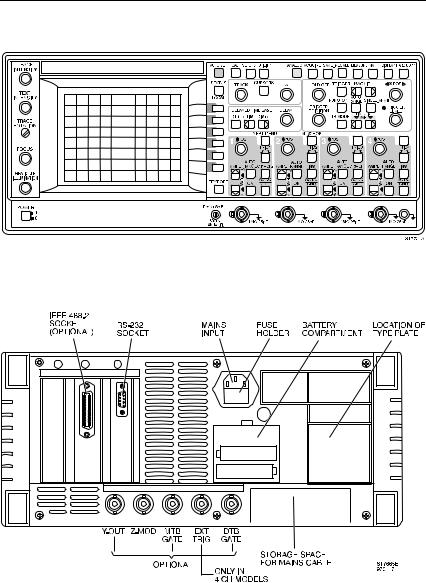
XII
FRONT VIEW
REAR VIEW

XIII
FRONT PANEL CONNECTIONS
Probe Adjust
Squarewave output signal for e.g. probe calibration.
Amplitude is calibrated.
CH1
BNC input socket for vertical channel 1 with probe indication contact.
CH2
BNC input socket for vertical channel 2 with probe indication contact.
CH3
BNC input socket for vertical channel 1 with probe indication contact. (only in 4 channel models)
CH4
BNC input socket for vertical channel 1 with probe indication contact. (only in 4 channel models)
EXT TRIG
BNC input socket used as an extra external trigger input with probe indication contact (only in 2 channel models)
Ground socket (banana): same potential as safety ground.
The measuring ground socket and the external conductor of the BNC sockets are internally connected to the protective earth conductor of the three-core mains cable. The measuring ground socket or the external conductor of the BNC-sockets must not be used as a protective conductor terminal.
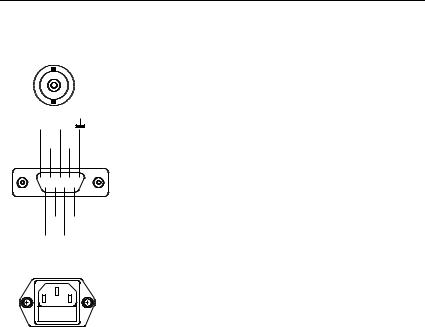
XIV
REAR PANEL CONNECTIONS
NC TXD
RXD DTR
1 



 5
5
6 


 9
9
RTS NC
DSR CTS NC=NOT CONNECTED
ST6065
FUSE
Z-MOD
BNC input socket for external intensity-modulation of the CRT trace.
RS-232 BUS (EIA-232-D)
Input/output socket to connect the oscilloscope to an RS-232 Interface.
LINE IN
Line input socket. Fuse holder is built in.
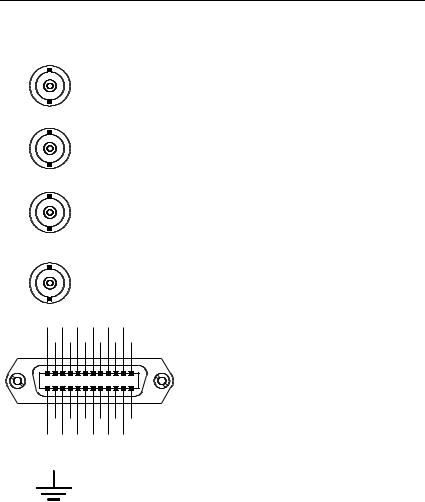
XV
OPTIONAL REAR PANEL CONNECTIONS
SHIELD SRQ NDAC DAV DIO4 DIO2
NR
ATN IFC FD EO1 DIO3 DIO1
12 |
1 |
24 |
13 |
GND GND GND REN DIO7 DIO5 |
||
11 |
9 |
7 |
LOGIC GND GND GND DIO8 DIO6 |
||
GND 10 |
8 |
6 |
CH1 Y-OUT
BNC output socket with a signal derived from the Channel 1 input signal.
MAIN TB GATE
BNC output socket with a signal that is "high" when the Main Timebase is running and "low" for the other conditions.
DTB GATE
BNC output socket with a signal that is "high" when the Delayed Timebase is running and "low" for the other conditions.
EXT TRIG (only in 4 channel models)
BNC input socket used as an extra external trigger input for the Main Timebase
IEEE 488.2 BUS OPTION
If installed you will find here the input/output socket to connect the oscilloscope to an IEEE 488 interface.
ST6064
The external conductor of the BNC sockets and the screening of the interface bus connectors are internally connected to the protective earth conductor of the three-core mains cable. The external conductor of the BNC sockets and the screening of the interface bus connectors must not be used as a protective conductor terminal.
OPERATORS SAFETY |
1 - 1 |
1 OPERATORS SAFETY
ATTENTION: The instrument is designed for indoor use only.
Read this page carefully before installation and use of the instrument.
1.1 INTRODUCTION
The instrument described in this manual is designed to be used by proper-ly- trained personnel only. Adjustment, maintenance and repair of the exposed equipment shall be carried out only by qualified personnel.
1.2 SAFETY PRECAUTIONS
For the correct and safe use of this instrument it is essential that both operating and service personnel follow generally-accepted safety procedures in addition to the safety precautions specified in this manual. Specific warning and caution statements, where they apply, will be found throughout the manual. Where necessary, the warning and caution statements and/or symbols are marked on the apparatus.
1.3 CAUTION AND WARNING STATEMENTS
CAUTION: Is used to indicate correct operating or maintenance procedures in order to prevent damage to or destruction of the equipment or other property.
WARNING: Calls attention to a potential danger that requires correct procedures or practices in order to prevent personal injury.

1 - 2 |
OPERATORS SAFETY |
1.4 SYMBOLS
Read the safety information in the manual.
Earth.
Conformité Européenne.
Recycling information.
1.5 IMPAIRED SAFETY PROTECTION
The use of the instrument in a manner not specified may impair the protection provided by the equipment. Before use, inspect the instrument and accessories for mechanical damage!
Whenever it is likely that safety-protection has been impaired, the instrument must be made inoperative and be secured against any unintended operation. The matter should then be referred to qualified technicians. Safety protection is likely to be impaired when, for example, the instrument fails to perform the intended measurements or shows visible damage.
1.6 MEASURING EARTH
The measuring earth socket and the external conductor of the BNC sockets are internally connected to the protective earth conductor of the three-core mains cable. The measuring earth socket or the external conductor of the BNC-sockets must not be used to connect a protective conductor.

INSTALLATION INSTRUCTIONS |
2 - 1 |
2 INSTALLATION INSTRUCTIONS
Attention: You are strongly advised to read this chapter thoroughly before installing your oscilloscope.
2.1 SAFETY INSTRUCTIONS
2.1.1Protective earthing
Before any connection to the input connectors is made, the instrument shall be connected to a protective earth conductor via the three-core mains cable; the mains plug shall be inserted only into a socket outlet provided with a protective earth contact. The protective action shall not be negated by the use of an extension cord without protective conductor.
WARNING: Any interruption of the protective conductor inside or outside the instrument is likely to make the instrument dangerous. Intentional interruption is prohibited.
WARNING: When an instrument is brought from a cold into a warm environment, condensation may cause a hazardous condition. Therefore, make sure that the grounding requirements are strictly adhered to.
2.1.2Mains voltage cord, mains voltage range and fuses
Before inserting the mains plug into the mains socket, make sure that the instrument is suitable for the local mains voltage.
NOTE: When the mains plug has to be adapted to the local situation, such adaption should be done by a qualified technician only.
WARNING: The instrument shall be disconnected from all voltage sources when a fuse is to be renewed.
The oscilloscope has a tapless switched-mode power supply that covers most nominal voltage ranges in use: ac voltages from 100 ... 240 V (r.m.s.). This obviates the need to adapt to the local mains (line) voltage. The nominal mains (line) frequency range is 50 Hz ... 400 Hz.
Line fuse rating: 3.15 AT delayed action, 250 V (for ordering code see "INITIAL INSPECTION").

2 - 2 |
INSTALLATION INSTRUCTIONS |
The mains (line) fuseholder is located on the rear panel in the mains (line) input socket. When the mains (line) fuse needs replacing, proceed as follows:
-disconnect the oscilloscope from the mains (line).
-remove the cover of the fuseholder by means of a small screwdriver.
-fit a new fuse of the correct rating and refit the cover of the fuseholder.
WARNING: Make sure that only fuses with the required rated current and of the specified type are used for replacement. The use of
makeshift fuses and the short-circuiting of fuse holders are prohibited.
REAR VIEW
Figure 2.1 Rear view of the instrument showing the mains input/fuse-holder and back-up battery compartment.
When the apparatus is connected to its supply, terminals may be live, and the opening of covers or removal of parts (except those to which access can be gained by hand) is likely to expose live parts.
The apparatus shall be disconnected from all voltage sources before it is opened for any replacement, maintenance or repair.
Capacitors inside the apparatus may still be charged even when the apparatus has been disconnected from all voltage sources.
Any maintenance and repair of the opened apparatus under voltage shall be avoided as far as possible and, when inevitable, shall be carried out only by a skilled person who is aware of the hazard involved.

INSTALLATION INSTRUCTIONS |
2 - 3 |
2.2 MEMORY BACK-UP BATTERIES
2.2.1General information
Memory backup is provided to store the oscilloscope’s settings when switched off so that the instrument returns to the same settings when turned on. Two AA (LR6) Alkaline batteries are used.
Note: |
The batteries are not factory installed and must be installed at the |
|
customer’s site. |
Note: |
This instrument contains batteries. Do not dispose of these batteries with |
|
other solid waste. Used batteries should be disposed of by a qualified |
|
recycler or hazardous materials handler. Contact your authorized Fluke |
|
Service Center for recycling information. |
2.2.2Installation of batteries
Proceed as follows:
-Remove all input signals and disconnect the instrument line power.
-Remove the plastic cover of the battery compartment so that the battery holder becomes accessible.
-Install two penlight batteries (AA) in the battery holder as indicated on the battery holder.
-Reinstall the cover of the battery compartment.
Note: Frontsettings and autocalibration data disappear after exchange of the batteries with the instrument disconnected from the line power. After battery exchange, it is necessery to press the CAL key after the recommended warming up time.
CAUTION: Never leave the batteries in the oscilloscope at ambient temperatures outside the rated range of the battery specifications because of possible damage that may be caused to the instrument. To avoid battery damage, do not leave the batteries in the oscilloscope when it is stored longer than 30 days.
2.3 THE FRONT COVER
For ease of removal and reinstallation, the front cover has been designed to snap on to the front of the instrument.
The front can be removed as follows:
-Fold the carrying handle down so that the oscilloscope occupies a sloping position (refer to Chapter 2.4 for how to proceed).
-Pull the clamping lip at the top side of the cover slightly outwards.
-Lift the cover off the instrument.

2 - 4 |
INSTALLATION INSTRUCTIONS |
2.4HANDLE ADJUSTMENT AND OPERATING POSITIONS OF THE INSTRUMENT
By pulling both handle ends outwards away from the instrument, the handle can be rotated to allow the following instrument positions:
-vertical position on its rear feet;
-horizontal position on its bottom feet;
-in three sloping positions on its handle.
The characteristics mentioned in the REFERENCE MANUAL are guaranteed for the specified positions or when the handle is folded down.
CAUTION: To avoid overheating, ensure that the ventilation holes in the covers are free of obstruction. Do not position the instrument in direct sunlight or on any surface that produces or radiates heat.
In the rear panel of the instrument there is storage space for the mains cable. There is also a clamping device to fix the end of the mains cable to the rear panel. The mains plug then fits in the area where the RS232 connector is present. In this way the instrument can also stand on its rear feet.
MAT4221
Figure 2.2 Instrument positions
2.5 IEEE 488.2/IEC 625 BUS INTERFACE OPTION
If your oscilloscope is equipped with the IEEE 488.2 interface, it can be used in a bus system configuration. The protocol used is SCPI (Standard Commands for Programmable Instruments). For setup information, refer to the function REMOTE CONTROL IEEE 488.2 in Chapter 5.
The IEEE 488.2 interface is a factory-installed option.
INSTALLATION INSTRUCTIONS |
2 - 5 |
2.6 RS-232-C SERIAL INTERFACE
Your oscilloscope is equipped with an RS-232-C interface as standard. The interface can be used in a system for serial communication. The protocol used is CPL (Compact Programming Language). CPL is a small set of very powerful commands that can be used for full remote control. Detailed information about this interface and the CPL protocol is given in Chapter 6 in this manual. For setup information, refer to the REMOTE CONTROL RS-232 function in Chapter 5 ’Function Reference’.
2.7 RACK MOUNTING
The rackmount kit (PM 8960/04) allows you to install the oscilloscope in a standard 19 inch rack.
It is not necessary to open the oscilloscope itself to mount the rackmount kit. Installation can be done easily by the user.
2.8 VERSIONS
The model number of your oscilloscope (e.g. PM33...) is indicated on the text strip above the CRT. This model number is also represented by the digits 6, 7, 8 and 9 of the 12digit code on the type plate on the rear panel. The ’A’ or ’B’ series is indicated by a 1 or 2 on the 5th digit.
The instrument’s serial number is also given on the type plate. This number consists of a six digit code preceeded by the characters ’DM’.
The instrument version can also be displayed on the CRT after having pressed menu key UTILITY and then softkey MAINTENANCE.
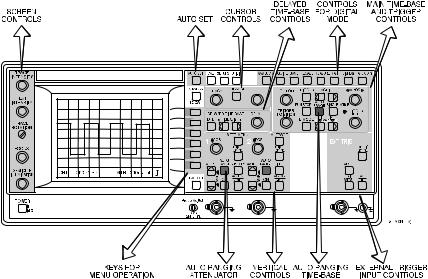
GETTING STARTED |
3 - 1 |
3 GETTING STARTED
This chapter provides a 10-minute tutorial intended for those who are not familiar with Fluke oscilloscopes. Those who are already familiar can skip this chapter and continue to Chapter 4.
3.1 FRONT-PANEL LAYOUT
This oscilloscope is a combination of an analog oscilloscope and a digital storage oscilloscope in the same instrument. The basic signal acquisition and display functions are identical in both operating modes. Differences will be explained in the text. Switching between the two operating modes is done with the yellow ANALOG key.
The front panel of the oscilloscope is organized into functional areas. The areas are discussed in order of typical operation.
Figure 3.1 Front panel layout
Note that the front panel shown is that with the most functions. Differences are explained in Section 4.1. For this getting started procedure, only CH1 and CH2 are used. These are identical for all models.
3 - 2 |
|
GETTING STARTED |
Typical operation of your instrument will be: |
|
|
- Switching on the instrument |
(see Section 3.2) |
|
- |
Initial standard setup |
(see Section 3.2) |
- |
Screen controls |
(see Section 3.3) |
- |
Auto setup |
(see Section 3.4) |
- |
Analog-Digital mode switching |
(see Section 3.5) |
- |
Vertical setup |
(see Section 3.6) |
- |
Timebase setup |
(see Section 3.7) |
- |
Magnify (Expand) |
(see Section 3.8) |
- |
Direct trigger setup |
(see Section 3.9) |
- |
Pretrigger view |
(see Section 3.10) |
- |
More advanced features |
(see Section 3.11) |
- |
Cursor operation |
(see Section 3.12) |
- More advanced trigger functions |
(see Section 3.13) |
|
- More signal detail with the DTB |
(see Section 3.14) |
|
- |
Trace storage |
(see Section 3.15) |
3.2 SWITCHING ON THE INSTRUMENT
Connect the power cord and set the front panel power switch to ON. For any line source between 100V to 240V nominal, 50/400 Hz, the instrument automatically turns on. After performing the built-in power-up routine, the instrument is immediately ready for use. The instrument’s settings will be identical to those when the oscilloscope was switched off (with the batteries installed).
To ensure that you will get the same setup in all cases, press the STATUS key and TEXT OFF key simultaneously. This will set the instrument in a predefined default condition (STANDARD SETUP) and a trace will appear on the screen. Text is also displayed at the bottom of the screen.
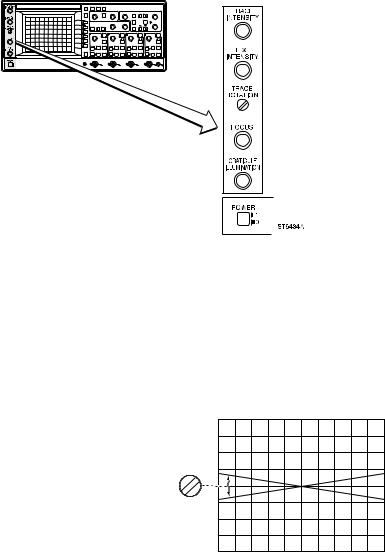
GETTING STARTED |
3 - 3 |
3.3 SCREEN CONTROLS
The screen controls can be adjusted for optimum trace, text and spot quality by the controls to the left of the screen.
Figure 3.2 Screen control area
The brightness on the screen is adjusted by two controls, one for the trace and one for the text.
•Turn the TRACE INTENSITY control clockwise and verify that only the brightness of the trace increases.
•Turn the TEXT INTENSITY control clockwise and verify that only the brightness of the text increases.
The sharpness of the trace and text is optimized by the FOCUS control.
When you are making photographs or are in a dark environment, you can use the ILLUMINATION control to illuminate the graticule of the screen.
The trace is adjusted in parallel with the horizontal graticule lines by the screwdriver-controlled TRACE ROTATION control.
TRACE
ROTATION
ST5975
9303
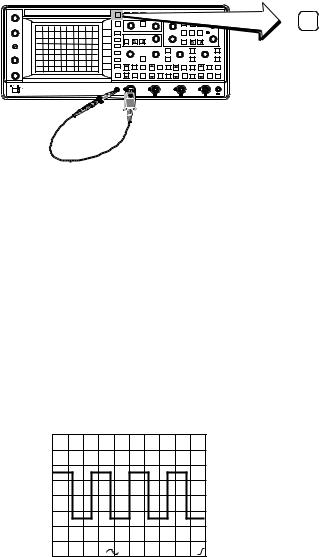
3 - 4 |
GETTING STARTED |
3.4 AUTO SETUP
The best way to start each measurement is by using the AUTOSET key. This automatically finds and scales all relevant parameters on all channels.
AUTO SET
1 |
2 |
3 |
4 |
ST6659
9303
Figure 3.3 Measuring setup
Step 1 Connect the probe as shown in figure 3.3.
NOTE: |
AUTOSET is programmable. Because you have set the instrument in the |
|
"standard setup" before (see Section 3.2), all programmable features are |
|
set to a predefined condition and the instrument is set in the analog mode. |
|
Programming of AUTOSET is explained in Chapters 4 and 5. |
Step 2 Press the AUTOSET key.
The scope flashes the message ’AUTO SETTING...’ on the screen. In a few seconds the front-panel settings are adjusted for an optimized display of the applied signal in the analog mode.
Step 3 The calibration signal is clearly displayed.
The parameters of the channel and the timebase settings are displayed at the bottom of the screen.
CH1 200mV |
MTB 200μs |
CH1 |
|
|
ST6704 |
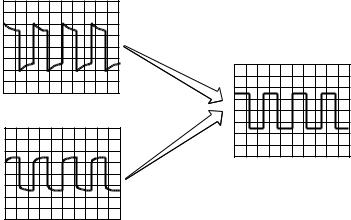
GETTING STARTED |
3 - 5 |
Step 4 To prevent measurement errors, check the pulse response before any measurement. If the pulse shows overshoot or undershoot, you can correct this by using the trimmer in the probe’s body. Chapter 4 describes how to adjust the pulse response.
ST5952
In most cases, using AUTO SETUP is sufficient for a good initial display of the signal(s). After the initial AUTOSET, and to optimize the signal for a more detailed view, continue with the paragraphs below.
NOTE: If you get lost when adjusting your instrument, just press AUTOSET.
3 - 6 |
GETTING STARTED |
3.5MODE SWITCHING BETWEEN ANALOG AND DIGITAL OPERATING MODES
You can use the yellow ANALOG key to switch from the analog mode to the digital mode and back at any time. The signal acquisition and display functions of both operating modes are very similar. However, the nature of the signals you are using may determine which operating mode you prefer to use. For more information, refer to the following table:
SIGNAL CRITERIA |
ANALOG MODE |
DIGITAL MODE |
Repetitive signals of |
Usable |
Usable |
30 Hz and higher |
|
|
Repetitive signals |
Causes display |
Preferred |
below 30 Hz |
flickering |
|
Single events |
Displayed for the |
Can capture and |
|
duration of |
display for long |
|
the event |
term display |
Repetitive signals that are |
Preferred |
May cause alaising |
amplitude modulated |
|
Use Peak detect or |
|
|
Envelope mode |
Repetitive signals that |
Preferred |
May cause aliasing. |
are modulated in frequency |
|
Use Envelope mode. |
Long serial data streams |
Preferred when |
When using delayed |
|
Delayed sweep |
sweep to observe |
|
is not used. |
details, Digital mode |
|
|
provides better |
|
|
light output. |
Video signals |
Preferred when |
When using delayed |
|
Delayed sweep |
sweep to observe |
|
is not used. |
details, Digital mode |
|
|
provides better |
|
|
light output. |
OTHER CRITERIA |
|
|
Need to see pretrigger |
Not possible |
Up to full acquisition |
information |
|
length |

GETTING STARTED |
|
|
|
3 - 7 |
|
SIGNAL CRITERIA |
|
|
ANALOG MODE |
DIGITAL MODE |
|
You need to make adjustments |
Fastest |
Slower |
|||
to the circuitry and watch |
|
display |
display |
||
the signal change |
|
|
update |
update |
|
Automatic measurements |
|
Can’t use |
Fully implemented |
||
Signal |
Math |
|
|
Add, Subtract |
All functions |
|
Add, Subtract, Multiply |
|
|
||
Signal |
Analysis |
|
|
Not available |
Full analysis |
|
Integration, |
|
|
|
(optional) |
|
Differentiation, FFT |
|
|
||
Automatic Pass/Fail test |
|
Not available |
Fully implemented |
||
|
|
|
|
|
(optional) |
Autorange attenuator |
|
|
Not available |
Results in a displayed |
|
|
|
|
|
|
signal with an ampli- |
|
|
|
|
|
tude of 2 to 6.4 divi- |
|
|
|
|
|
sions |
Autorange timebase |
|
|
Not available |
Results in a signal |
|
|
|
|
|
|
display of 2 to 6 |
|
|
|
|
|
waveform periods |
|
|
|
|
ANALOG |
|
|
1 |
2 |
3 |
4 |
|
|
|
|
|
|
RUN/STOP |
ST6680
9312
Figure 3.4 Analog-Digital switching setup
Step 1 Press AUTOSET. The scope performs an AUTOSET in analog mode.
Step 2 Press the ANALOG key to change over to the digital mode. Check that the picture is identical to the one in the analog mode. The text ’DIGITAL MODE’ is displayed briefly at the bottom of the screen.
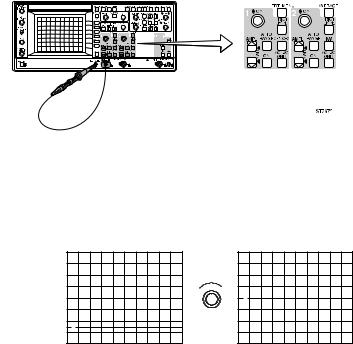
3 - 8 |
GETTING STARTED |
Step 3 Press AUTOSET again. This time the scope performs the autoset in digital mode.
Step 4 Press the RUN/STOP key and observe that the trace is frozen and stays on screen even after removing the probe.
Step 5 Press the RUN/STOP key to display the actual input signal again. Reconnect the probe to display the Probe Adjust signal again.
Step 6 Press the ANALOG button once again to return to the analog mode. In the bottom of the screen, the text ’ANALOG MODE‘ is briefly displayed.
3.6 VERTICAL SETUP
This section deals with setting of the input circuits of the four channels. The main adjustments are AMPLitude, POSition, and the channel input coupling selection for GND, DC, and AC.
|
|
|
|
|
|
|
|
|
|
|
|
|
|
|
|
|
|
|
|
|
|
|
|
|
|
|
|
|
|
|
|
|
|
|
|
|
|
|
|
|
|
|
|
|
|
|
|
|
|
|
|
|
|
|
|
|
|
|
|
|
|
|
|
|
|||||
Figure 3.5 |
Vertical setup |
||||||||||||
|
|
|
|
|
|
|
|
|
|
|
|
|
|
Step 1 Adjust the absolute ground level by disconnecting the signal and using the POS control to position the trace in the middle of the screen. A marker with the channel number (’1-’) at the left of the screen indicates the ground reference.
POS 
1

1

MAT4191
Step 2 Reconnect the probe to the Probe Adjust signal for display.
